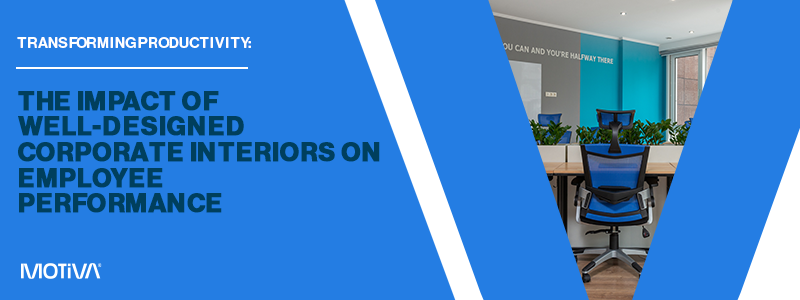In the modern corporate landscape, the physical environment in which employees work plays a pivotal role in shaping their performance and overall well-being. It is widely acknowledged that well-designed corporate environments can significantly improve employee productivity.
This article delves into the various aspects of corporate interior design that contribute to enhanced productivity and explores the benefits of investing in a thoughtfully crafted interior space.
- The Power of a Thoughtful Layout
A well-designed corporate environment starts with a thoughtful layout that considers both the functional and aesthetic aspects of the workspace. A layout that promotes efficient workflow and encourages collaboration can have a profound impact on employee productivity. Open floor plans, flexible workstations, and strategically placed meeting areas all contribute to a more conducive work environment.
- Lighting for Inspiration
Proper lighting is crucial for creating an inspiring and productive workspace. Natural light is preferred whenever possible, as it not only reduces energy costs but also enhances mood and alertness. Additionally, well-designed artificial lighting should be adjustable to cater to individual preferences and tasks.
- Ergonomics and Comfort
Employee comfort is paramount for productivity. Ergonomically designed furniture and seating that support good posture can reduce physical strain and discomfort, allowing employees to focus on their tasks for longer periods without distractions.
- Incorporating Nature and Biophilic Design
The integration of nature into corporate environments, often referred to as biophilic design, has gained popularity for its positive impact on productivity. Incorporating elements like indoor plants, natural materials, and views of nature can reduce stress, boost creativity, and improve overall well-being.
- Color Psychology
Colors have a profound effect on human psychology and can significantly influence mood and behavior. Well-chosen color schemes in corporate environments can stimulate creativity, enhance focus, and contribute to a positive atmosphere.
- Sound Management
Noise pollution is a common productivity disruptor in the workplace. Incorporating sound-absorbing materials, providing quiet zones, and using white noise machines can help manage noise levels and create a more peaceful working environment.
- Encouraging Collaboration and Communication
Well-designed corporate environments should facilitate collaboration and communication among employees. Common spaces, meeting rooms, and breakout areas can encourage impromptu discussions and idea-sharing, ultimately leading to increased innovation and productivity.
- Personalization and Ownership
Allowing employees to personalize their workspaces and have a sense of ownership over their environment can boost morale and motivation. Customizable workstations and personal storage spaces are examples of how personalization can be integrated into the design.
- Technology Integration
A modern workplace relies heavily on technology. Well-designed interiors should seamlessly integrate technology, providing easy access to power outlets, Wi-Fi, and audio-visual equipment to support productivity.
- Sustainable Design for Well-being
Sustainability is not only essential for environmental responsibility but also for employee well-being. Sustainable design elements, such as energy-efficient lighting, recycled materials, and good indoor air quality, can create a healthier and more productive workspace.
- Flexibility for Changing Needs
The corporate landscape is dynamic, and the workspace should be adaptable to changing needs. Flexible furniture arrangements and modular designs allow for easy adjustments as the organization evolves.
- Employee Well-being Initiatives
Beyond physical design, corporate interiors can incorporate initiatives that promote employee well-being, such as fitness areas, meditation rooms, and wellness programs. These amenities contribute to a healthier and happier workforce, which, in turn, enhances productivity.
- Measuring the Impact
To gauge the effectiveness of a well-designed corporate environment, organizations can implement productivity metrics, conduct employee surveys, and track absenteeism and turnover rates. These data-driven insights can help fine-tune the workspace to continually optimize productivity.
Investing in well-designed corporate environments is not merely an aesthetic choice; it is an investment in employee productivity and overall business success. A thoughtfully planned workspace that prioritizes comfort, collaboration, and employee well-being can yield significant returns in terms of improved performance, innovation, and employee satisfaction. In a world where competition is fierce, organizations that recognize the importance of their physical environments and its impact on productivity will undoubtedly stand out as employers of choice and leaders in their industries.

